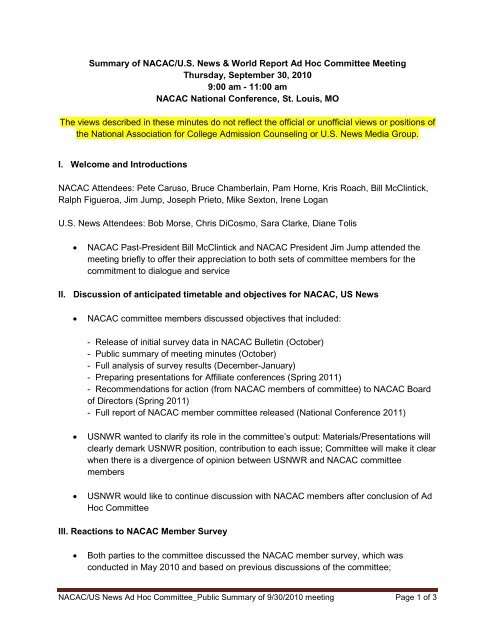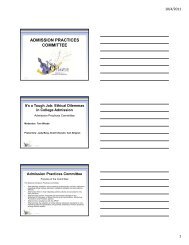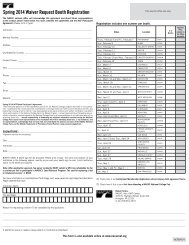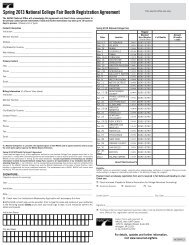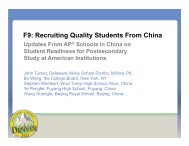Summary of NACAC/U.S. News & World Report Ad Hoc Committee ...
Summary of NACAC/U.S. News & World Report Ad Hoc Committee ...
Summary of NACAC/U.S. News & World Report Ad Hoc Committee ...
You also want an ePaper? Increase the reach of your titles
YUMPU automatically turns print PDFs into web optimized ePapers that Google loves.
<strong>Summary</strong> <strong>of</strong> <strong>NACAC</strong>/U.S. <strong>News</strong> & <strong>World</strong> <strong>Report</strong> <strong>Ad</strong> <strong>Hoc</strong> <strong>Committee</strong> Meeting<br />
Thursday, September 30, 2010<br />
9:00 am - 11:00 am<br />
<strong>NACAC</strong> National Conference, St. Louis, MO<br />
The views described in these minutes do not reflect the <strong>of</strong>ficial or un<strong>of</strong>ficial views or positions <strong>of</strong><br />
the National Association for College <strong>Ad</strong>mission Counseling or U.S. <strong>News</strong> Media Group.<br />
I. Welcome and Introductions<br />
<strong>NACAC</strong> Attendees: Pete Caruso, Bruce Chamberlain, Pam Horne, Kris Roach, Bill McClintick,<br />
Ralph Figueroa, Jim Jump, Joseph Prieto, Mike Sexton, Irene Logan<br />
U.S. <strong>News</strong> Attendees: Bob Morse, Chris DiCosmo, Sara Clarke, Diane Tolis<br />
� <strong>NACAC</strong> Past-President Bill McClintick and <strong>NACAC</strong> President Jim Jump attended the<br />
meeting briefly to <strong>of</strong>fer their appreciation to both sets <strong>of</strong> committee members for the<br />
commitment to dialogue and service<br />
II. Discussion <strong>of</strong> anticipated timetable and objectives for <strong>NACAC</strong>, US <strong>News</strong><br />
� <strong>NACAC</strong> committee members discussed objectives that included:<br />
- Release <strong>of</strong> initial survey data in <strong>NACAC</strong> Bulletin (October)<br />
- Public summary <strong>of</strong> meeting minutes (October)<br />
- Full analysis <strong>of</strong> survey results (December-January)<br />
- Preparing presentations for Affiliate conferences (Spring 2011)<br />
- Recommendations for action (from <strong>NACAC</strong> members <strong>of</strong> committee) to <strong>NACAC</strong> Board<br />
<strong>of</strong> Directors (Spring 2011)<br />
- Full report <strong>of</strong> <strong>NACAC</strong> member committee released (National Conference 2011)<br />
� USNWR wanted to clarify its role in the committee’s output: Materials/Presentations will<br />
clearly demark USNWR position, contribution to each issue; <strong>Committee</strong> will make it clear<br />
when there is a divergence <strong>of</strong> opinion between USNWR and <strong>NACAC</strong> committee<br />
members<br />
� USNWR would like to continue discussion with <strong>NACAC</strong> members after conclusion <strong>of</strong> <strong>Ad</strong><br />
<strong>Hoc</strong> <strong>Committee</strong><br />
III. Reactions to <strong>NACAC</strong> Member Survey<br />
� Both parties to the committee discussed the <strong>NACAC</strong> member survey, which was<br />
conducted in May 2010 and based on previous discussions <strong>of</strong> the committee;<br />
<strong>NACAC</strong>/US <strong>News</strong> <strong>Ad</strong> <strong>Hoc</strong> <strong>Committee</strong>_Public <strong>Summary</strong> <strong>of</strong> 9/30/2010 meeting Page 1 <strong>of</strong> 3
preliminary results were available to committee members. Among discussion points<br />
were:<br />
- Further analysis <strong>of</strong> survey results for committee and for public<br />
- Reliance on rankings by international students<br />
- Concerns with the emphasis <strong>of</strong> the peer assessment survey<br />
- Effects <strong>of</strong> methodology on data reporting on colleges and other organizations;<br />
desire to allow individuals to organize the ranking data themselves based on their<br />
own weights/preferences<br />
� USNWR discussed the presence <strong>of</strong> multiple college data publishers who are publishing<br />
much <strong>of</strong> some <strong>of</strong> the same basic non-ranking college data that U.S. <strong>News</strong> is publishing,<br />
existence <strong>of</strong> other rankings, and demand for information in the marketplace; noted<br />
existence <strong>of</strong> large amounts <strong>of</strong> data, and that the value-added is from organizing and<br />
making sense <strong>of</strong> it for consumers<br />
� USNWR discussed changes in the media industry that have affected print publications,<br />
including magazines, with a resulting shift toward digital content<br />
� <strong>Committee</strong> will release data from survey throughout the fall, culminating in a survey<br />
report in December 2010/January 2011<br />
� <strong>NACAC</strong> committee members noted that some <strong>of</strong> the member survey is predictable,<br />
some is contradictory; for example, survey results suggest that members think rankings<br />
encourages counter-productive behavior, but few identified their own institution as the<br />
source <strong>of</strong> such behavior<br />
IV. Discussion <strong>of</strong> recent changes to US <strong>News</strong> rankings methodology, publication<br />
� <strong>NACAC</strong> committee members drew attention to the peer assessment portion <strong>of</strong> the<br />
methodology—member survey indicated the most member concern about methodology<br />
focused on peer assessments<br />
� USNWR has reduced the weight <strong>of</strong> the academic peer survey in the National<br />
Universities and National Liberal Arts categories in the current year’s methodology<br />
(published 8/17/10) by 10 percentage points.<br />
� Questions about organization <strong>of</strong> the U.S. <strong>News</strong> ranking by Carnegie Classifications were<br />
raised; USNWR had discussed internally and with many in higher education over the<br />
years that its old names <strong>of</strong> categories were not self-evident to some users. As a result,<br />
the ranking category names were changed on 8/17/10. UNEWS felt that the new<br />
categories have become significantly better than in previous years based on recent<br />
feedback by colleges; <strong>NACAC</strong> members noted that there are still categories that<br />
combine colleges that are substantially dissimilar<br />
<strong>NACAC</strong>/US <strong>News</strong> <strong>Ad</strong> <strong>Hoc</strong> <strong>Committee</strong>_Public <strong>Summary</strong> <strong>of</strong> 9/30/2010 meeting Page 2 <strong>of</strong> 3
� Do the rankings drive institutions to perform better, encourage student success? Some<br />
<strong>NACAC</strong> committee members noted that data collection has made colleges pay attention<br />
to data like retention and graduation; other committee members noted that such<br />
attention should be paid with or without rankings.<br />
� <strong>NACAC</strong> and USNWR committee members discussed concerns with selectivity<br />
measures, including test scores and acceptance rate; USNWR noted that acceptance<br />
rate is a small part <strong>of</strong> the total ranking methodology, many others are oriented around<br />
student characteristics.<br />
� USNWR discussed changes to rankings since last year, including<br />
- Category names changed from Carnegie based names to national and/or<br />
regional<br />
- Previously USNWR numerically ranked the top half <strong>of</strong> each category, now rank<br />
the top 75 percent <strong>of</strong> each ranking category<br />
- Bottom quarter <strong>of</strong> each category now called the second tier, previously there<br />
were more tiers<br />
- Some schools reported that they had better rankings based solely on the new<br />
presentation system U.S. <strong>News</strong> used.<br />
- Increased the weight <strong>of</strong> 6-year graduation rate performance in the National<br />
Liberal Arts Colleges and National Universities categories.<br />
- <strong>Ad</strong>ded more written description <strong>of</strong> schools<br />
- National Universities and National Liberal Arts rankings incorporated high<br />
school counselor recommendations for the first time<br />
- If they are going to add the counselor recommendations to all the ranking<br />
categories, they will need to perform a much larger survey, which is not currently<br />
feasible<br />
� Some <strong>NACAC</strong> committee members questioned the use <strong>of</strong> class rank in the ranking<br />
methodology, since it is no longer used by many secondary and postsecondary schools;<br />
also raised the point that class rank is an entry characteristic. U.S. <strong>News</strong> points out that<br />
high school class rank is still used in public college admissions in Texas, Florida and<br />
California--the three largest states.<br />
� Some <strong>NACAC</strong> committee members commented positively on this year’s editorial<br />
content, which showed a wide range <strong>of</strong> institutions<br />
V. Conclusion and Next Steps<br />
� <strong>NACAC</strong> <strong>Committee</strong> members will pursue timeline and objectives as stated in section I,<br />
will inform USNWR members on progress<br />
<strong>NACAC</strong>/US <strong>News</strong> <strong>Ad</strong> <strong>Hoc</strong> <strong>Committee</strong>_Public <strong>Summary</strong> <strong>of</strong> 9/30/2010 meeting Page 3 <strong>of</strong> 3
� Final face-to-face meeting <strong>of</strong> full committee will take place at <strong>NACAC</strong> National 2011<br />
Conference in New Orleans<br />
<strong>NACAC</strong>/US <strong>News</strong> <strong>Ad</strong> <strong>Hoc</strong> <strong>Committee</strong>_Public <strong>Summary</strong> <strong>of</strong> 9/30/2010 meeting Page 4 <strong>of</strong> 3


